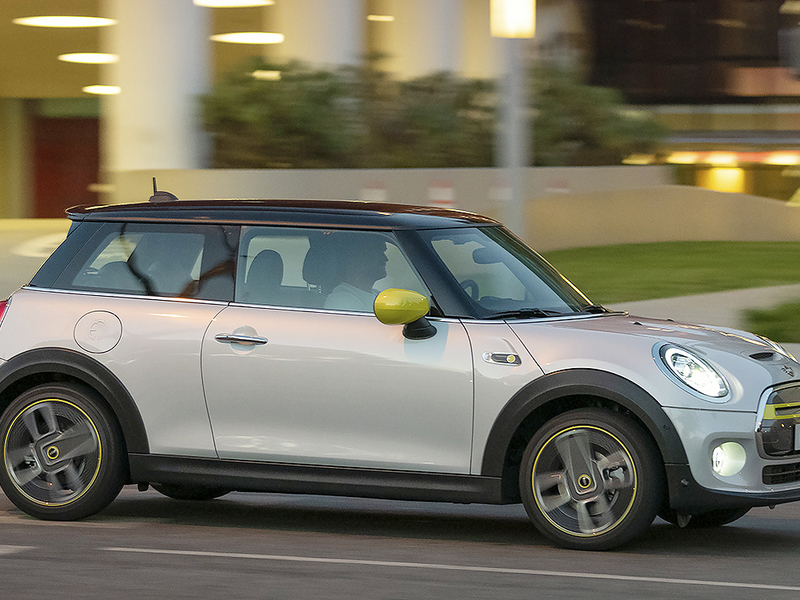
Joining the electric vehicle field this year is the Mini Cooper SE. The EV has a 32.6-kWh battery that delivers an EPA-estimated range of about 110 miles. The SE’s electric motor delivers 181 hp and can accelerate from 0 to 60 mph in 6.9 seconds. The Cooper SE will start at $30,750, including shipping, when it lands in March. State and federal EV tax credits would knock the price down to as low as $18,750, depending on where the vehicle is sold. We’ve rounded up and highlighted some Cooper SE reviews from the automotive media.
“Steer the Cooper SE onto an on-ramp, and it hangs on ferociously. It wouldn’t be a surprise if, in terms of sheer grip, this is the most capable Mini. The small, 12-module battery means that its quoted curb weight stays at a reasonably svelte 3,153 pounds, and the T-shaped pack’s mounting position (between the front seats and under the rear seats) works wonders for both its center of gravity and weight balance.”
— Ezra Dyer, Car and Driver
“Coming off the throttle, regenerative braking engagement is a little too abrupt as well. The system offers two modes, neither of which try for the one-pedal driving that other EVs revel in, but even the stronger setting doesn’t follow that quick initial bite with real significant stopping power. You’ll find yourself using the regular friction brakes far more than you would in a Nissan Leaf Plus, for example. That would be fine were those pads and calipers set up to be a little less twitchy, but as such, driving a Mini SE smoothly requires an inordinate amount of focus.”
— James Gilboy, The Drive
“The best part about the Mini SE, as we learned in our earlier, brief drive last year, is that it drives exactly like a Mini. Visibility is good, the additional weight over the standard car doesn’t feel like a big penalty (unless, perhaps, you were to drive the two back to back) and there’s just not a lot of car surrounding you, which makes the connection to the road just a little more prevalent.
What’s important is the SE doesn’t drive like the parts-bin special that it is. Moving the batteries from the original Mini E from the seats down into the actual structure of the car helps lower the center of gravity, giving the car solid grounding and a sensation that you could push it maybe just a little harder than a combusting Mini two-door.
As with most EVs, the throttle is immediate, surging the car forward without your body, your back squishing into the seat and catching up with the rest of the car just a fraction slower. What’s even more impressive, though, is the acceleration while you’re already cruising. This is the complete opposite of what happens in an original Mini (pre-BMW), and yet somehow it feels perfectly suited to the car.”
— Justin T. Westbrook, Jalopnik
“Simply put, Miami’s flat, straight and traffic-choked roads make for a miserable place to assess a car for anything other than commuting manners. Fortunately, commuting is likely to be very important to Mini Electric owners, and in this scenario, the little juicebox sparkles.
It takes a few miles to get used to the SE’s deceleration rate if you’ve got its adjustable regenerative braking on its high setting like I did most of the time. However, once you get acclimated, this one-pedal driving method is thoroughly enjoyable and it simultaneously stashes as many electrons away for later use as possible.”
— Chris Paukert, Roadshow by CNET
“Around town, this is a nippy car, able to blast from traffic lights eagerly. In that way, the Cooper SE improves the point-and-squirt nature of the Mini brand. It’s fun to surge ahead on an uninterrupted wave of torque. This car can cruise on the freeway happily, although deploying the power does require some strategy before executing passes. The other powertrain bits work well, too.”
— Brandon Turkus, Motor1
“The most remarkable thing about driving the Cooper SE electric is how unremarkable the driving experience is, at least from the standpoint of what we’ve come to expect from Mini. The car tips the scales at 3,163 pounds, but still feels light on its feet, and the low center of gravity enhances the traditional go-kart dynamics of Mini’s entry-level model.
The powertrain itself is smooth and silent, though at speed there’s the usual amount of wind and tire noise — in fact a bit more of the latter since the higher inflation pressure of 39 psi (which reduces rolling resistance) does result in it a bit of drumming over uneven freeway surfaces.”
— Matt DeLorenzo, Kelley Blue Book